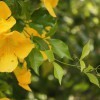Abstract
Cat’s-claw vine is a neotropical, climbing perennial that produces large and showy yellow flowers in the springtime. It is valued as an ornamental, particularly in dry areas, because it needs little water or care and can climb almost anything, covering fences and other structures with an attractive carpet of leaves and flowers. Unfortunately, the aggressive nature of the vine has made it a major weed in China, Australia, South Africa, and parts of the southeastern United States. This 6-page fact sheet provides guidance on identification, control, and similar native vines for home landscapes. Written by Niels Proctor and Jason Smith, and published by the UF Department of School of Forest Resources and Conservation, October 2014. Revised June 2018.
References
Anonymous. 2010. "Giant cat's claw discovered: Weed control worker stunned by massive creeper." The Daily Examiner, Grafton, New South Wales, Australia.
Boyne, Richard L., Susan P. Harvey, Kunjithapatham Dhileepan, and Tanya Scharaschkin. 2013. "Variation in leaf morphology of the invasive cat's claw creeper Dolichandra unguis-cati (Bignoniaceae)." Australian Journal of Botany no. 61 (6):419–423. https://doi.org/10.1071/BT13063
Center for Aquatic and Invasive Plants. 2014. Cat's-claw vine. University of Florida [accessed 4/23 2014]. Available from http://plants.ifas.ufl.edu/node/259.
da Silva, M., R. W. Barreto, and O. L. Pereira. 2012. "Fungal pathogens of 'cat's claws' from Brazil for biocontrol of Macfadyena unguis-cati." Mycotaxon no. 119 (Journal Article):181–195. https://doi.org/10.5248/119.181
IFAS Invasive Plant Working Group. 2014. IFAS Assessment of Non-Native Plants in Florida's Natural Areas. 2008 [accessed 9/4/14 2014]. Available from http://plants.ifas.ufl.edu/assessment/.
King, A. M., H. E. Williams, and L. G. Madire. 2011. "Biological control of cat's claw creeper, Macfadyena unguis-cati (L.) AHGentry (Bignoniaceae), in South Africa." African Entomology no. 19 (2):366–377. https://doi.org/10.4001/003.019.0213
Lohmann, Lúcia G., and Charlotte M. Taylor. 2014. "A New Generic Classification of Tribe Bignonieae (Bignoniaceae)." Annals of the Missouri Botanical Garden no. 99 (3):348–489. https://doi.org/10.3417/2003187
Osunkoya, O. O., K. Pyle, T. Scharaschkin, and K. Dhileepan. 2009. "What lies beneath? The pattern and abundance of the subterranean tuber bank of the invasive liana cat's claw creeper, Macfadyena unguis-cati (Bignoniaceae)." Australian Journal of Botany no. 57 (2):132–138. https://doi.org/10.1071/BT09033
Rafter, M. A., A. J. Wilson, K. A. D. Wilmot Senaratne, and K. Dhileepan. 2008. "Climatic-requirements models of cat's claw creeper Macfadyena unguis-cati (Bignoniaceae) to prioritise areas for exploration and release of biological control agents." Biological Control no. 44 (2):169–179. https://doi.org/10.1016/j.biocontrol.2007.10.015
UCD Department of Plant Sciences. 2014. ENH 105 | Macfadyena unguis-cati. University of California at Davis 2009 [accessed 9/4 2014]. Available from http://www.plantsciences.ucdavis.edu/courses/enh105/labs/08/MAUN.html.
Ward, Daniel B. 2005. Putting a Stop to the Cat-claw Vine Infestation in Gainesville. Wildland Weeds, Summer, 2005, 17.

